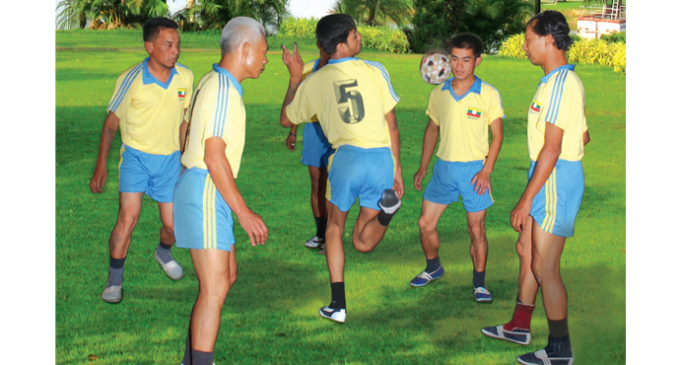Chinlon, the Cane-Ball Game

It is a game yet one would think it to be a dance. It exhibits so many choreographic elements which seem to come straight from the court dances of an earlier day. The grace of movement, the shaping of form in space, the resilience of the speaking body, the design of the postures. Nothing is more dance-like than the curves and lines followed by the body and the limbs in playing the salwe-gyi, the “royal sash”. The chinlon drops to the player from behind his head and shoulder, and he strikes it with his foot which moves in a graceful curve. Throughout the performance the player’s eyes follow the path by which the chinlon enters his strike point. Our eyes are drawn by his glance and we join him in gliding along that path. As the stroke ends in a tableau we realize the player is creating for us the beauty of a dance posture even while he is imparting to us the joy of Play.
It is a display of jugglery yet remains a game. Only an exquisite sense of timing and disposition of space render the skilful execution of the kaba-nyunt, the ” tendril of the world”. The spread of the player’s limbs serves as the base to balance the trajectory of the chinlon as it follows a curved path from one side of the player’s body to the other. And just as it seems that it must touch the ground and go out of play, the sideward stretched foot catches it and the toes send it up again like a fairy in flight against the gold and blue of the tropical evening.
 It is the expression of artistic creativity yet demands the physical feat of the athlete. Only the bold artist who has confidence in his ability to express himself in the chosen medium would dare to attempt the waik-gyi, the “great circling”. As the chinlon rushes back to hug the earh, the player throws himself into the air and strikes it with his instep to toss it back to the sky. Meanwhile, he has completed a turn in the air. He does not fall to the ground in a sprawl, but lands in a crouch while he faces in the original direction. He does this stroke not once but five, eight, then times succcessively, spinning in high space till space itself becomes alive. Only an athlete could possess the stamina to execute these movements with such precision. This is an exhibition of stasis awakening to movement and then subsiding again int stasis.
It is the expression of artistic creativity yet demands the physical feat of the athlete. Only the bold artist who has confidence in his ability to express himself in the chosen medium would dare to attempt the waik-gyi, the “great circling”. As the chinlon rushes back to hug the earh, the player throws himself into the air and strikes it with his instep to toss it back to the sky. Meanwhile, he has completed a turn in the air. He does not fall to the ground in a sprawl, but lands in a crouch while he faces in the original direction. He does this stroke not once but five, eight, then times succcessively, spinning in high space till space itself becomes alive. Only an athlete could possess the stamina to execute these movements with such precision. This is an exhibition of stasis awakening to movement and then subsiding again int stasis.
It is a game for cooperative endeavour yet provides opportunity for the exhibition of the highest form of individual skill. The player keeps the chinlon high and places it in the best position so that a team-mate can get under it to play his various strokes, to assume his initial posture, follow the stroke through and then hold the final pose. The player’s task is not just to “feed ” the other players, it is for him to use his initiavtive to perform the more intricate and difficult strokes, perhaps consecutively, so that he gains points for his team. And so it goes round the five players facing each other in an enclosing circle.
After nursing the physical bruises and mental abrasions from the play, one is delighted by the harmless nature of this game. It goes fullest in eliminating any element which might cause injury to body or spirit. Though there is competition one does not face the opponents. Each team plays its own game and displays its skills. So there can be no occasion to display antagonism. One plays in the friendliest of environments because one plays in a circle of one’s own team-mates.
This is the game of chinlon. Our national game. Long may it be enjoyed.
U Win Pe
./wp-content/uploads/2018/10/Emirate-Online-TDY.png)
















There are no comments at the moment, do you want to add one?
Write a comment